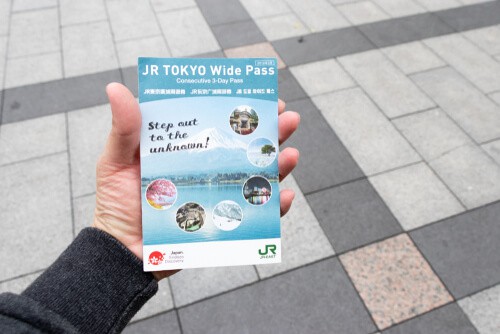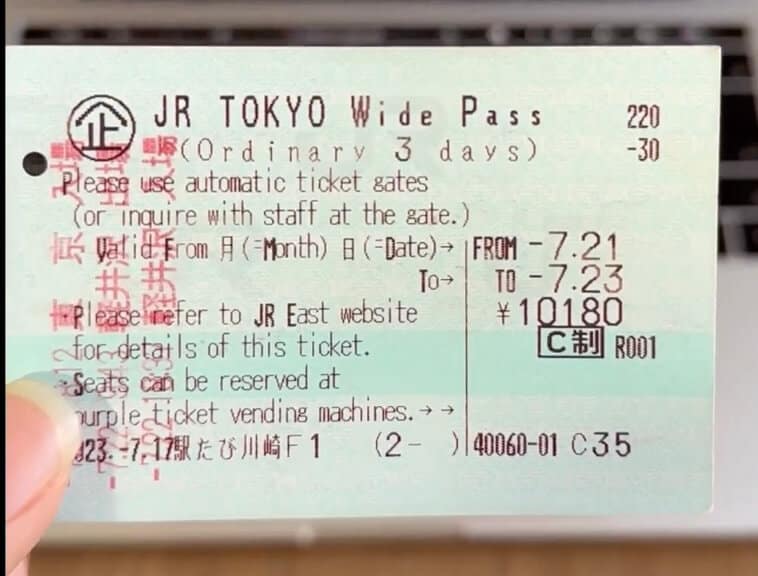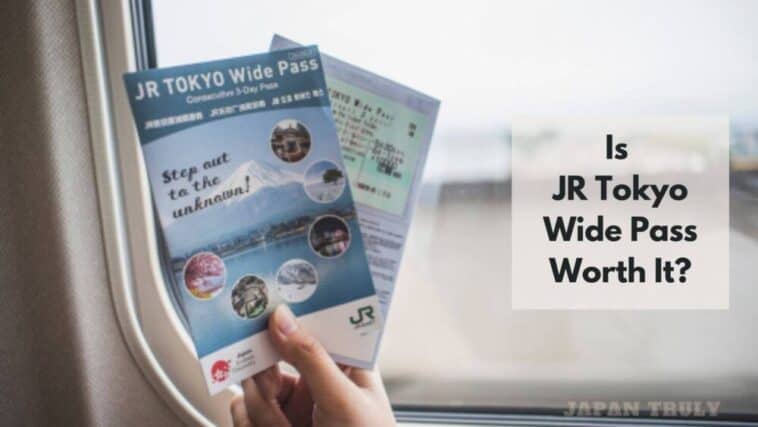The JR Tokyo Wide Pass is a popular option for tourists who want to explore the Tokyo region and nearby destinations. But is Tokyo Wide Pass worth it? This article will help you decide whether or not the Tokyo Wide Pass is right for you, based on your travel plans and budget.
The JR Tokyo Wide Pass is a three-day pass that gives you unlimited travel on JR East trains in the Tokyo region, including some Shinkansen routes. It also covers travel on select lines operated by other companies, such as the Fujikyu Railway and the Izu Kyuko Line.
The Tokyo Wide Pass can save you a lot of money on train fares, especially if you plan on making multiple-day trips from Tokyo. For example, a round-trip Shinkansen ticket from Tokyo to Nikko costs over ¥10,000.
But with the Tokyo Wide Pass, you can travel to Nikko and other nearby destinations for free as many times as you want.

So, is the Tokyo Wide Pass worth it? It depends on your travel plans and budget. If you are planning on making multiple day trips from Tokyo, the pass can save you a lot of money. But if you only plan on staying in Tokyo and visiting local attractions, you may be better off purchasing individual train tickets.
In this article, we will take a closer look at the Tokyo Wide Pass, including its coverage, cost, and benefits. We will also help you decide whether or not the pass is right for you.
Page Contents
Is Tokyo Wide Pass Worth It?
The Tokyo Wide Pass offers unlimited travel on JR trains in the Kanto region for 3 or 5 consecutive days. It’s a cost-effective choice for tourists planning to explore destinations beyond Tokyo, like Nikko, Hakone, and Yokohama.
If you intend to make multiple day trips within the region and value the convenience of not buying individual tickets for each journey, it’s worth considering.
However, it’s exclusively available to foreign tourists, so Japanese residents and long-term visitors can’t use it.
Assess your travel plans, and if they align with the pass’s coverage and duration, it can be a worthwhile investment.

- Related: Is Tokyo Metro Pass Worth It? |
What is the Tokyo Wide Pass?
The Tokyo Wide Pass is a regional rail pass offered by the Japan Railway Group. This pass is specifically designed for tourists and allows unlimited travel on JR trains within the Kanto region for a set number of consecutive days.
The Kanto region encompasses Tokyo and its surrounding areas, making it an attractive option for travelers who want to explore beyond the city limits.

Benefits of the Tokyo Wide Pass
- Unlimited JR Train Travel: With the Tokyo Wide Pass, you can travel unlimited times on JR trains within the designated area. This includes not only the Tokyo Metropolitan area but also destinations like Nikko, Kamakura, and even parts of the Izu Peninsula.
- Cost Savings: For travelers planning to make multiple day trips outside Tokyo, the pass can offer substantial cost savings compared to purchasing individual tickets for each journey. It’s especially economical if you intend to explore a variety of destinations within the Kanto region.
- Convenience: The Tokyo Wide Pass is convenient and easy to use. Once you have it, there’s no need to purchase separate tickets for each trip within the covered area, which can save both time and hassle.
- Flexibility: You can choose between a 3-day or a 5-day pass, giving you the flexibility to tailor your travel itinerary to your preferences. This flexibility can be particularly advantageous for travelers who want to take their time exploring different areas.
- Access to Popular Tourist Destinations: The pass grants access to numerous popular tourist spots, including Nikko, Kawagoe, Yokohama, and the hot spring resorts of Hakone and Atami, all within a day’s journey from Tokyo.
Limitations of the Tokyo Wide Pass
- Exclusively for Tourists: The Tokyo Wide Pass is only available to foreign tourists visiting Japan on a short-term visa. Japanese residents and long-term visitors are not eligible.
- Valid on JR Trains Only: The pass is valid solely on JR trains within the designated region. It does not cover other transportation options like subways, buses, or private rail companies.
- Limited Coverage: While the pass offers access to many popular destinations, it may not cover every place on your itinerary. Be sure to check the map and coverage area to ensure it suits your travel plans.
- Short Usage Period: The pass is valid for either 3 or 5 consecutive days. If your trip extends beyond this duration, you’ll need to purchase additional tickets for any extra days of travel.
Should You Get The Tokyo Wide Pass?
Determining whether the Tokyo Wide Pass is worth it depends on your travel plans and preferences. Here are some factors to consider:
- Travel Itinerary: If you plan to explore multiple destinations within the Kanto region, especially those outside of Tokyo, the pass can offer substantial savings and convenience.
- Duration of Stay: The pass is most beneficial for travelers spending at least 3 to 5 days in the region. If you’re staying in Tokyo for a shorter period and don’t plan on venturing outside the city, it may not be the best investment.
- JR Train Preference: If you primarily intend to use JR trains for your travels, the Tokyo Wide Pass aligns perfectly with your transportation needs.
- Value of Convenience: Consider how much you value the convenience of not having to buy individual tickets for each trip. For some travelers, this alone justifies the pass.
Ultimately, the Tokyo Wide Pass is a valuable option for tourists who want to explore beyond Tokyo and make the most of their time in the Kanto region.
Before making a decision, carefully assess your travel plans, and calculate whether the pass will provide cost savings based on your intended destinations and duration of stay.
If it aligns with your itinerary, it can be an excellent way to enhance your Japanese adventure while keeping your budget in check.
Tips for Maximizing the Value of Your Tokyo Wide Pass
If you’ve decided that the Tokyo Wide Pass is the right choice for your trip, here are some tips to help you maximize its value:
- Plan Your Itinerary Carefully: Take the time to plan your day trips and activities within the Kanto region. Make a list of the places you want to visit and the JR train routes that will take you there. This will help you make the most of your pass’s coverage.
- Check Train Schedules: Be aware of train schedules, especially if you’re visiting places like Nikko or Hakone, which may have less frequent train service. Planning your day to align with train times can save you time and ensure a smooth journey.
- Activate Your Pass Strategically: The Tokyo Wide Pass is valid for a specific number of consecutive days starting from the date of activation. Make sure to activate it on a day that aligns with your travel plans to get the most out of it.
- Combine with Other Passes: Depending on your travel plans, you might consider combining the Tokyo Wide Pass with other transportation passes. For instance, you could use a separate Tokyo Metro pass or a Suica/PASMO card for subway and bus travel within Tokyo.
- Reserve Seats for Longer Journeys: If you plan to take longer train journeys, especially during peak travel seasons, consider reserving seats in advance to ensure a comfortable and hassle-free trip. Some trains may have limited reserved seating, so book early if needed
- Explore Off-Peak Hours: Try to schedule your journeys during off-peak hours to avoid crowded trains and maximize your comfort during travel.
- Learn Basic Japanese Phrases: While many train station staff in Japan can speak some English, learning a few basic Japanese phrases can be helpful, especially when asking for directions or assistance.
- Use Hyperdia: The Hyperdia website or app is an excellent tool for checking train schedules, routes, and fares. It can help you plan your journeys efficiently, ensuring you make the most of your Tokyo Wide Pass.
How many days is the Tokyo wide pass good for?
The JR Tokyo Wide Pass is good for three consecutive days. This means that you can use it on any three days in a row, starting from the day you activate it. For example, if you activate your pass on a Tuesday, you can use it on Tuesday, Wednesday, and Thursday.
The pass is valid for unlimited travel on JR East trains in the Tokyo region, including some Shinkansen routes. It also covers travel on select lines operated by other companies, such as the Fujikyu Railway and the Izu Kyuko Line.
The Tokyo Wide Pass is a good option for tourists who want to explore the Tokyo region and nearby destinations, such as Nikko, Hakone, and Kawaguchiko. It can save you money on train fares, especially if you plan on making multiple trips.
Here are some examples of popular day trips that you can take with the Tokyo Wide Pass:
- Nikko: Visit the Toshogu Shrine, a UNESCO World Heritage Site, and the Kegon Falls, one of the most beautiful waterfalls in Japan.
- Hakone: Take a boat ride on Lake Ashi, visit the Hakone Open-Air Museum, and relax in a traditional Japanese onsen (hot spring).
- Kawaguchiko: Take a boat ride on Lake Kawaguchiko, visit the Fuji Five Lakes Museum, and enjoy the views of Mount Fuji.
If you are planning on making more than three day trips from Tokyo, you may want to consider purchasing a Japan Rail Pass instead. The Japan Rail Pass is valid for seven, fourteen, or twenty-one consecutive days and covers unlimited travel on most JR trains throughout Japan.
What does the JR Tokyo wide pass cover?
The JR Tokyo Wide Pass covers unlimited travel on JR East trains in the Tokyo region, including some Shinkansen routes. It also covers travel on select lines operated by other companies, such as the Fujikyu Railway and the Izu Kyuko Line.
Here is a more detailed list of the trains and lines that are covered by the JR Tokyo Wide Pass:
- JR East trains:
- All local, rapid, express, and limited express trains in the Tokyo region, including some Shinkansen routes (see below)
- Other trains and lines:
- Fujikyu Railway (entire line)
- Izu Kyuko Line (entire line)
- Tokyo Monorail (entire line)
- Joshin Dentetsu Line (entire line)
- Saitama New Urban Transit (New Jõetsu Shinkansen Series E7 Shuttle)
- Tokyo Waterfront Area Rapid Transit (entire line)
Shinkansen routes covered by the JR Tokyo Wide Pass:
- Hokuriku Shinkansen to Sakudaira, via the resort town of Karuizawa (in Nagano prefecture)
- Jōetsu Shinkansen to Gala Yuzawa, via the hot spring town Echigo Yuzawa (in Niigata prefecture)
- Tōhoku Shinkansen to Nasu Shiobara (in Tochigi prefecture)
Please note that the JR Tokyo Wide Pass does not cover travel on the following JR lines:
- JR Yamanote Line
- JR Keihin-Tohoku Line
- JR Keiyo Line
- JR Saikyo Line
- JR Shonan-Shinjuku Line
- Tokyo Metro lines
If you need to travel on any of these lines, you will need to purchase a separate ticket.
Does Tokyo Wide Pass cover Fuji excursion?
Yes, the JR Tokyo Wide Pass covers the Fuji Excursion train. The Fuji Excursion train is a limited express train operated by the Fujikyu Railway, and it runs from Shinjuku Station in Tokyo to Kawaguchiko Station, which is located on the shores of Lake Kawaguchiko, one of the Fuji Five Lakes.
The Fuji Excursion train is a popular choice for tourists who want to visit Mount Fuji, as it offers stunning views of the mountain throughout the journey. The train also stops at several stations in the Fuji Five Lakes region, making it easy to explore the area.
To use the Fuji Excursion train with the JR Tokyo Wide Pass, simply show your pass to the conductor when boarding the train. You will not need to purchase a separate ticket.
Here are some tips for using the Fuji Excursion train with the JR Tokyo Wide Pass:
- The Fuji Excursion train departs from Shinjuku Station several times a day. You can check the schedule on the Fujikyu Railway website.
- The Fuji Excursion train is a popular train, so it is advisable to book your tickets in advance, especially if you are traveling during peak season.
- The Fuji Excursion train has both reserved and non-reserved seats. If you want to guarantee a seat, you should book a reserved seat.
- The Fuji Excursion train offers a variety of amenities, including free Wi-Fi, power outlets, and a dining car.
Does Tokyo wide pass include Narita Express?
Yes, the JR Tokyo Wide Pass includes the Narita Express. The Narita Express is a limited express train that runs from Narita Airport to Tokyo Station, Shinjuku Station, and Ikebukuro Station.
To use the Narita Express with the JR Tokyo Wide Pass, simply show your pass to the conductor when boarding the train. You will not need to purchase a separate ticket.
The Narita Express is a convenient and comfortable way to travel from Narita Airport to Tokyo.
The trains are spacious and have plenty of legroom, and they offer free Wi-Fi.
Here are some tips for using the Narita Express with the JR Tokyo Wide Pass:
- The Narita Express departs from Narita Airport several times an hour. You can check the schedule on the JR East website.
- The Narita Express is a popular train, so it is advisable to book your tickets in advance, especially if you are traveling during peak season.
- The Narita Express has both reserved and non-reserved seats. If you want to guarantee a seat, you should book a reserved seat.
- The Narita Express offers a variety of amenities, including free Wi-Fi, power outlets, and a dining car.
Who should get the Tokyo wide pass?
The JR Tokyo Wide Pass is a good option for tourists who want to explore the Tokyo region and nearby destinations, such as Nikko, Hakone, and Kawaguchiko. It can save you money on train fares, especially if you plan on making multiple trips.
Here are some specific groups of people who may benefit from getting the JR Tokyo Wide Pass:
- Tourists who are staying in Tokyo and want to take day trips to nearby destinations. The pass covers travel on some Shinkansen routes, which can save you a lot of money on train fares.
- Tourists who are interested in visiting multiple attractions in the Tokyo region. The pass covers travel on all JR East trains in the Tokyo region, including the Yamanote Line, which circles central Tokyo.
- Tourists who are traveling on a budget. The JR Tokyo Wide Pass can save you a lot of money on train fares, especially if you plan on making multiple trips.
Here are some examples of popular day trips that you can take with the JR Tokyo Wide Pass:
- Nikko: Visit the Toshogu Shrine, a UNESCO World Heritage Site, and the Kegon Falls, one of the most beautiful waterfalls in Japan.
- Hakone: Take a boat ride on Lake Ashi, visit the Hakone Open-Air Museum, and relax in a traditional Japanese onsen (hot spring).
- Kawaguchiko: Take a boat ride on Lake Kawaguchiko, visit the Fuji Five Lakes Museum, and enjoy the views of Mount Fuji.
If you are not planning on making multiple day trips from Tokyo, or if you are interested in visiting destinations that are not covered by the JR Tokyo Wide Pass, you may want to consider purchasing a different type of rail pass.
For example, the Japan Rail Pass is a good option for tourists who want to travel extensively throughout Japan.
Ultimately, the decision of whether or not to get the JR Tokyo Wide Pass depends on your individual travel plans and budget. If you are unsure whether or not the pass is right for you, you can use the JR East website to calculate the savings that you would make.
My writing focuses on the various aspects of Japanese lifestyle, from traditional tea ceremonies and flower arrangement to modern fashion trends and pop culture. Through my articles, I aim to share my passion for Japan and provide readers with a glimpse into the rich and diverse world of Japanese culture.
I believe that the key to understanding Japanese lifestyle is to appreciate the balance between tradition and innovation. While Japan has a rich cultural heritage that dates back centuries, it is also a country that is constantly evolving and embracing new ideas and technologies.
Whether you’re interested in learning about the latest fashion trends in Tokyo, or want to explore the ancient art of calligraphy, my writing will take you on a journey through the many facets of Japanese lifestyle. So join me as we explore the beauty and complexity of this fascinating culture together!





